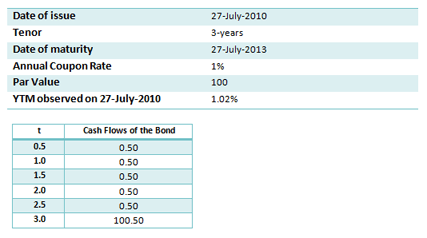In this post, we will consider how the Black-Derman-Toy (BDT) short rate binomial tree will be used to price bonds.
For example, we illustrate the use of the short rates to price a hypothetical 3-year fixed income bond at issue as follows:

Using the observed YTM and the excel price formula the price of the security works out to 99.94. Using the BDT model we are able to determine the price of the fixed income bond based not on a single yield rate, but on a complete short rate term structure projected over future time periods. For example, given the hypothetical bond above the price is calculated by starting with the final cash flow and working back to the issue date as follows:
Step 1: Deriving the short rate tree
Using the median short rates and the up movements together with the procedure for deriving the short rates given above, the binomial tree for 6 month (0.5) intervals till the bond’s maturity date is as follows:

Step 2: Discounting the cash flows

At Duration 3, the cash flow is the maturity value, i.e. the face amount + the coupon payment.
At Duration 2.5 the calculation of (C ) is done as follows:
=0.5 × (A+B) ×exp (-Short Rate (D) × Length of interval) + Coupon
=0.5 × (100.50+100.50) ×exp(-5.26%×0.5) +0.50
=98.39
This procedure is repeated for each node as we work backwards to the valuation date. The discounted value so derived on the valuation date is the price of the bond which as we can see above works out to 99.94.
We reviewed the process of obtaining the price of bonds from the BDT short rate binomial tree. In the next post we will consider how the results of the BDT model may be used to price options of bonds.
